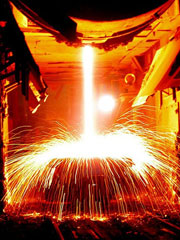World Metal Production Surges

via 2 dogs/flickr
In 2008, more than 1.4 billion
tons of metals were produced globally--double the quantity
of the late 1970s and more than seven times as much as in
1950. Trends since the late 1990s have been driven by the
dramatic growth of the Chinese economy. The figure for
metals production includes aluminum, arsenic, cadmium,
chromium, copper, gold, lead, mercury, nickel, and steel.
According to the latest Vital Signs snapshot of metals
production worldwide:
- China's steel production
skyrocketed from 66 million tons in 1990 to 500 million
tons in 2008, accounting for 38 percent of the world's
total. The next largest producers in 2008, following at
a considerable distance, were Japan at 119 million tons
and the United States at 91 million tons.
- The energy intensity and
carbon emissions of steel production vary greatly by
country. Mills in Italy, Germany, South Korea, and Japan
are among the most energy efficient worldwide. China
contends with old and inefficient facilities but is
making major strides in modernizing its industry.
- A growing amount of steel is
now produced from recycled scrap material, the result of
changing economics and environmental considerations.
Recycling saves 40-75 percent of the energy needed to
produce virgin steel.
This new metal production update includes the latest
figures on global production of steel and aluminum.
Read the Vital Signs analysis,
"World Metal Production Surges," by Michael Renner.
Complete trends will be available with full endnote
referencing, Excel spreadsheets, and presentation-ready
charts as part of our new subscription service,
Vital Signs Online, slated to launch this fall.
|
Worldwatch
Institute - 1776 Massachusetts Avenue, NW,
Washington, DC 20036
Tel +1 202.452.1999 - Fax 202.296.7365 -
www.worldwatch.org |
|
|
